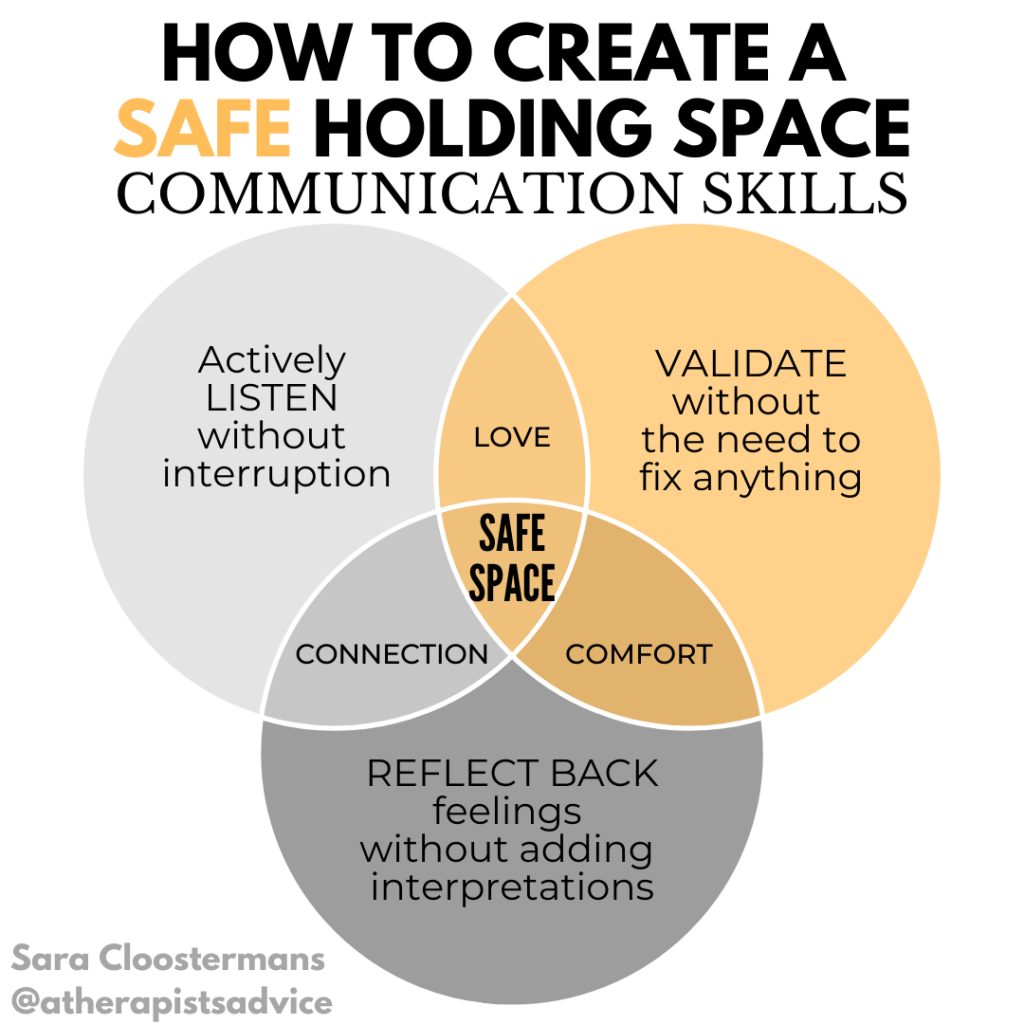When you create a safe holding space for a grieving loved one, you carefully see them through their mourning journey by using communication skills for grief that show acceptance and understanding, genuine empathy, as well as care and support.
Some of these communication skills are:
1. Actively listening without interruption
2. Validating without the need to fix anything
3. Reflecting back feelings without adding interpretations
These communication skills are some of the “basic attending skills” used in counseling to deepen the connection between the therapist and the client. They are meant to encourage clients to safely share their vulnerabilities with the hope that, because there is now a “shared experience” through storytelling, the clients’ emotional burden becomes lighter as time goes on.


What does it mean “to actively listen”?
You can show that you are actively listening to someone by the use of both non-verbal and verbal communication. When you hold appropriate eye contact, have an open posture, occasionally nod or shake your head, or let out a sigh or an “um-hum,” it indicates that you are attentive.
When you adjust your proximity to the grieving person’s needs (this may include an occasional hug, hand-holding, or a pat on the shoulder), it demonstrates that you care.
The first duty of love is to listen.
Paul Tillich
What does it mean to validate someone?
You validate someone by paraphrasing them—repeating back the information that they are sharing with you. Of course, you do not repeat back word-for-word what they just told you (about their memories of the deceased, for example). You summarize what they said using slightly different wording.
By validating the grieving person, you show acceptance and understanding of their thoughts and beliefs, even though you may not always agree with some of the things they recall about the deceased. They may have selective memory and temporarily remember the deceased as a saint. That may be far from the truth, but this is not the time to prove them wrong.
What does it mean to reflect back someone’s feelings?
Reflecting back feelings is similar to paraphrasing, but includes a feeling. This is either an obvious feeling you picked up on or the repetition of feeling words that the grieving person expressed out loud.
Here is one example for each scenario:
Scenario 1 – an obvious feeling you picked up on
The grieving person, Angie, is angry and smashes a picture frame on the floor; her husband died suddenly and Angie is now forced to parent their three children by herself. In this scenario, you obviously do not join in with smashing random objects on the floor.
Instead, you change your tone of voice, so that it matches the anger. Instead of a calm voice, your voice is a little louder and more intense than your soothing voice, but still controlled. Then you could say: “I understand that you are angry because you are now having to raise your three little ones by yourself without the help of their dad.”
Then add something comforting—“I will help you clean this up and make us a cup of tea. Whenever you are ready to brainstorm about how you can delegate some of your parenting responsibilities, I’m here for you.”
Scenario 2 – the repetition of feeling words that the grieving person expressed out loud
The same grieving person, Angie, is now crying incessantly while sharing the way she found out the tragic news of the loss of her husband. She tells you that she was in complete disbelief about his death all the way up until the moment that she identified his body. She adds how angry she felt for not being able to say goodbye to the man she considered to be her forever soulmate.
A reflection of feelings could sound something like this: “Oh, Angie, I can barely believe this awful tragedy myself. I am so sorry that you have to go through this. I can understand that you are in complete shock and feel devastated for having lost the love of your life. He will be so missed; such incredible sadness all around—I’m here for you.”
And yes, if you feel the need to cry with Angie, cry with her, even in a therapist-client relationship. When I taught clinical practicum classes to future therapists, my graduate students were under the impression that crying with a client during a session would always be considered unprofessional regardless of the circumstances. I told them that I feel differently about this. I explained that, of course, crying hysterically would not be appropriate; as therapists, we want to avoid clients having to take care of us at all costs. But, showing emotions (in a regulated way) that match the intensity of a painful event that someone is going through is not only appropriate, but also beneficial for their healing. It shows our humanity while we bear witness to the pain and suffering of others.
To help the students better understand my feelings about this, I gave them the following example: “Let’s say you have been working with a female adult client throughout her pregnancy and then find out when she shows up to her next session, scheduled for after her delivery date, that her daughter was stillborn. Here she is, your client, big belly still, empty-handed, without her newborn. So again, yes, I give you permission to cry. You are allowed to show your client how much you are sharing in her sorrow.”
This movie is a piercing example of the depth of loss I’m talking about. It shows how it would be next to impossible—and unhelpful—not to show emotion.
Additional Communication Skills For Grief:
- Show curiosity: ask questions, open-ended questions mostly:
- “Tell me more about Doug (the deceased)?”
- “What are some of your favorite memories of Doug?”
- “What will you miss most about Doug?”
- “Do you have any pictures of Doug that you would like to show me? Tell me more about these pictures.”
- Be a vault: keep everything the grieving person shares with you private and confidential, so that they can continue to trust you (unless you feel that they are unsafe—then you need to breach confidentiality and seek out help for them).
- Set a block of time aside to dedicate solely to the grieving person—actually schedule it in your calendar the way you schedule any meeting—so you have a sense of when the interaction begins and when it will end. During your togetherness, follow the grieving person’s lead in the conversation. Use your basic attending skills listed above. Do not change the subject or look for distractions. Stay fully attuned and, remember, this is only for a limited time.
Yield2Yin
- Healing Card Deck: A Therapist’s Advice 55-Card Healing Deck by Sara Cloostermans
- Book Recommendation: Atlas of the Heart: Mapping Meaningful Connection and the Language of Human Experience by Brené Brown
- Mantra: I AM SUPPORT // repeat with diaphragmatic breathing
- Yin Yoga Asana: Seal Pose
This page includes Amazon Associate affiliate links, which means I may earn a small commission at no cost to you if you purchase a product I suggest. I only recommend products I believe in. Learn more HERE.







